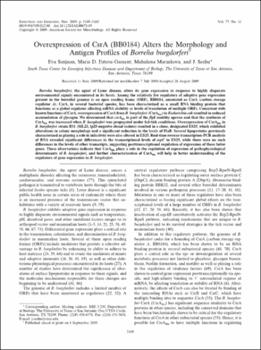Overexpression of BbCsrA (BB0184) alters morphology and antigen profiles in Borrelia burgdorferi
Date
2009Abstract
Borrelia burgdorferi, the agent of Lyme disease, alters its gene expression in response to highly disparate environmental signals encountered in its hosts. Among the relatively few regulators of adaptive gene expression present in the borrelial genome is an open reading frame (ORF), BB0184, annotated as CsrA (carbon storage regulator A). CsrA, in several bacterial species, has been characterized as a small RNA binding protein that
functions as a global regulator affecting mRNA stability or levels of translation of multiple ORFs. Consistent with
known functions of CsrA, overexpression of CsrA from B. burgdorferi (CsrABb) in Escherichia coli resulted in reduced accumulation of glycogen. We determined that csrABb is part of the flgK motility operon and that the synthesis of
CsrABb was increased when B. burgdorferi was propagated under fed-tick conditions. Overexpression of CsrABb in
B. burgdorferi strain B31 (ML23, lp25-negative clonal isolate) resulted in a clone, designated ES25, which exhibited
alterations in colony morphology and a significant reduction in the levels of FlaB. Several lipoproteins previously
characterized as playing a role in infectivity were also altered in ES25. Real-time reverse transcription-PCR analysis
of RNA revealed significant differences in the transcriptional levels of ospC in ES25, while there were no such
differences in the levels of other transcripts, suggesting posttranscriptional regulation of expression of these latter
genes. These observations indicate that CsrABb plays a role in the regulation of expression of pathophysiological
determinants of B. burgdorferi, and further characterization of CsrABb will help in better understanding of the
regulators of gene expression in B. burgdorferi.





